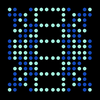Brand New Challenge! Visualize it with Pi!
Anyone can visualize data with a traditional computer display, but we want to see what you can do with LED strips or panels. Use a Raspberry Pi to interpret data from sensors, Internet sources, or other inputs and display it in a novel and/or artistic fashion that's both informative and fun to look at.
LED strips and panels have little in common with a computer monitor, and we're asking you to lean into that. Get abstract. Get conceptual. Embrace animation. Be subtle. Be flamboyant. When visualizing data, clarity is key, but for this contest creativity is king. The ideal project is something that works on multiple levels, engaging people who have no idea what it is, then opening a door to information once it's true purpose is explained.
The following examples are included for inspiration, but may not meet this contest's requirements: World of Light, Biological & Environmental Feedback LED Wristband, American Constitution Candle.
For more inspiration, join the Raspberry Pi chat.
Awards and Prizes
- Grand Prize
- Best visualization of data from directly connected sensor
- Best visualization of data from Internet source
- Best visualization of esoteric data source
Winning entries may have an opportunity to be displayed at the Hackaday Superconference.
How To Enter
Use a Raspberry Pi to drive LED strips or panels and document it as a new project on Hackaday.io. Once you have published your project, look in the left sidebar for the "Submit project to..." menu and enter it in the 'Visualize It With Pi" contest':
Entries must consist of:
- Full description, details, instructions, components, and build instructions.
- Source code and relevant schematics.
- Photos or video documenting a functioning version of the project.
The following restraints are placed:
- Project must use a Raspberry Pi device and LED strips or panels.
- Project must be open source.
- Each hackaday.io account may enter no more than 5 projects.
- The project must actually work ("fulfill its purpose").
Deadlines and Important Dates
- Contest starts August 21st
- Contest ends October 1st
- All these deadlines are at 15:00 UTC/ 09:00 PDT on the specified date.
Judging Criteria
- The judges will decide on the winning projects approximately within 2 weeks of October 1st.
- The number of likes on your project won't directly influence the winner of the contest, but judges may take them into consideration during judging.
- Judges will rate designs based on usefulness, innovation, creativity, and engineering.
- Users may win more than one prize, should the judges feel this makes sense.
 Ilyas Akhmetzyanov
Ilyas Akhmetzyanov Tillo
Tillo Aileen Xi
Aileen Xi





Good!